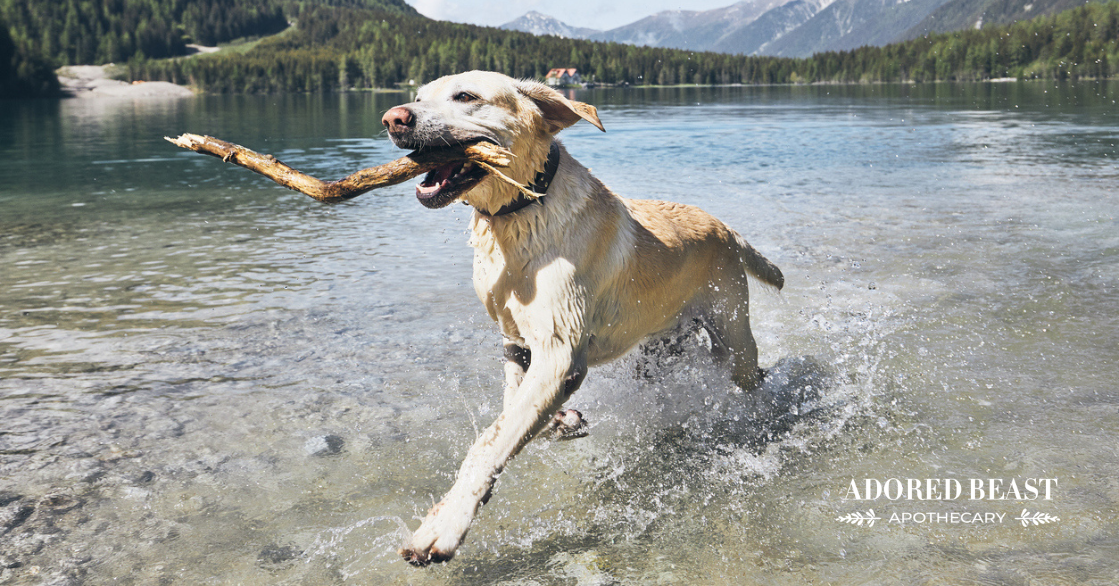How often do you walk your dog, let them romp the woods, or take them for a swim?
Just as it is for us, exercise is vital for maintaining the physical and mental well-being of our canine companions. The body needs to move to stay healthy.
April is Active Dog Month, and whether you’re reading this in April, or October (or any other month), it’s so important that we’re providing our dogs with the right exercise – and in the right amounts!
So, in this blog, we’ll explore the benefits of exercise for dogs, and answer the question, “how much exercise does a dog need” at various life stages, including puppies and senior dogs.
Why Walk (or Run, or Swim…)?
We all know that our dogs need exercise. But have you ever actually thought about why?
Regular exercise offers so many benefits for our dogs, including:
- Physical Health: Exercise helps your pup maintain a healthy weight, strengthens muscles and bones, improves cardiovascular health, and enhances overall physical fitness. It even improves cell health – every cell in the body benefits from exercise.
- Mental Stimulation: When you walk your dog, they get to encounter so many different sights, sounds, and smells. This stimulates the mind, which can help reduce boredom and stress, and prevent destructive behaviours associated with pent-up energy.
- Socialization: If your dog enjoys it (that’s key, as some don’t), exercise can provide opportunities for them to socialize with other animals and humans, promoting positive interactions and reducing anxiety.
- Bonding: We may just think of exercise as a way to keep fit and have fun, but it also helps to strengthen the bond between you and your pet, fostering trust and companionship.
So, we know it’s important, but how much exercise does a dog need?
How Much Exercise Does a Dog Need?
This sounds like such a simple question, but it’s actually fairly complex. The amount of exercise a dog needs depends on a variety of factors. Their breed, their age, and their ability all play into the answer.
1. Age
How much exercise does a dog need at each life stage?
Puppies have boundless energy, and so letting them run around all day or walking them many times a day may seem like common sense, but too much too early can be detrimental. Growing puppies need extra attention when it comes to proper joint development. You don’t want to overdo it. Follow the 5-minute rule – 5 minutes of walking for each month. So a 5 month old puppy can do about 25 minutes, twice a day.
Teenage and adult dogs generally need anywhere from 30 minutes to 2 hours (or more) of exercise per day. You can break this up into a few walks or one long one, or different types of activity throughout the day. (Again, this depends on your dog.)
For seniors, exercise is still very important. It keeps the joints and muscles limber and flexible. Just keep in mind that some exercises can do more harm than good. Middle-aged and senior dogs may find certain activities too hard on their joints. If your pet is older, or if arthritis is a concern, perhaps break up long walks into a few shorter walks during the day. Swimming – if they like it – is an excellent way to keep them active.
Avoid overexerting your senior pet or asking them to do too much. If you need to pull your dog along, or your dog is lagging behind, you’re NOT doing them any favours.
2. Breed
Breed matters too.
Large breed puppies grow quickly but mature slowly, so hold off on excessive activities like agility until they are fully grown. In contrast, smaller breeds mature more quickly, but they tend to have less tolerance for high-level exercise.
As adults, breeds with higher energy levels, such as border collies or Labrador retrievers, may need more vigorous activities to satisfy their needs. Working breeds may need different types of activity – if they like having a job to do, they will want that “working” element in addition to the movement. Some breeds, though, have other boundaries. Greyhounds, whippets, and other sighthounds are not built for long distance running, for example. Short-nosed or brachycephalic breeds are not suited to prolonged strenuous exercise – they don’t want to run a marathon with you, we promise.
3. Ability
Once you factor in age and breed, you also want to consider your individual dog’s abilities.
For example, if your dog is carrying a little extra holiday weight, exercise can be an important part of getting them to a healthy weight. But, you don’t want to go full-tilt right out of the gate. Start slowly and build up gradually to help avoid any injury.
Also, if your dog is unwell or injured, they won’t need as much exercise as usual – resting is an important part of recovery. Rest them as much as your vet advises, and find other ways to keep them entertained so they don’t get bored and frustrated. We love brain games to feed that need for mental stimulation.
Remember, many dogs, regardless of age or ability, will push through, even when they’re uncomfortable. They’ll continue to walk or play, even when they should stop. And they may not even let us know unless we’re paying very close attention!
The Best Types of Exercise
Just like us, every dog has their own personality and preferences! It’s important to make sure your dog enjoys the exercise you’re asking them to do, and change things up if they’re not into it.
And they like variety! It’s nice to switch things up on a regular basis. This helps to engage the difference senses, to move all the different parts of the body, and to make it fun!
There are lots of different of choices – and honestly, the best type depends on you and your pup!!
Here are some of the ones the ABA team picked as faves for our dogs:
- Walking: Regular walks are a fundamental form of exercise for dogs, providing cardiovascular benefits, mental stimulation, and opportunities for exploration.
- Running and Jogging: For high-energy breeds or active dogs, running or jogging alongside their owners can be an excellent way to burn off excess energy and maintain fitness.
- Agility or Flyball: These are great for dogs who like the focus and challenge!
- Hiking: A nice wander through the woods can be a great way to connect with nature and step out of the noise.
- Playtime: Fetch, tug-of-war, ball – these engage both the body and mind, promoting physical coordination and mental stimulation. Remember to warm up!
- Swimming: Swimming is a low-impact exercise that is gentle on joints and muscles, making it ideal for dogs with arthritis or mobility issues.
- Cycling: With proper training, many dogs take to cycling really well! Make sure you have the right safety set up.
Exercise is essential for promoting the health and well-being of dogs at every stage of life. So, how much exercise does a dog need? The amount ultimately depends on your dog. Whether it’s a leisurely walk around the neighbourhood, an exhilarating game of fetch, or a refreshing swim in the lake, finding activities that suit your dog’s needs and preferences is key to building a strong bond and ensuring optimal health for years to come.












